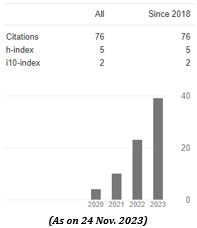Force based Design Approach for Seismic Evaluation of Padma Multipurpose Bridge Pier at Different Performance Levels
Abstract
The Padma Multipurpose Bridge (PMB) is one of the biggest megaprojects of Bangladesh connecting one third of the country with the capital city, Dhaka. The infrastructure is expected to produce considerable uplift on the nation’s transport system, the national and regional economy, employment, household income, and ultimately, poverty reduction. From construction and river management points of view, it is the most difficult and engineering innovation-intenstive project in the world. Hence the Padma Multipurpose Bridge (PMB) required analytical, computational and experimental studies. In this work, a 3D Finite Element (FE) model of the actual PMB containing a single (6x150m) 900m modules has been developed in MIDAS Civil, a commercial computer program for bridges. P-y soil spring model following API guideline has been developed to conform flexible support system of the bridge pier. Following BNBC 2020, the bridge's performance has been evaluated for the 475-year, 975 years, and 2475-year return periods for Service Level, Design Basis and the Maximum Credible Earthquake (MCE), respectively. The forced based design shows that the bridge pier reached only 28% and 36% of its axial and shear capacity respectively for an earthquake return period of 2475 years. On the other hand, the pier has reached a maximum of 41% of its total shear capacity for the same seismic level.
Downloads
References
Ahmed, K. S., Habib, M. A. & Asef, M. F. (2021a). Flexural response of stainless steel reinforced concrete beam. Structures, 34, 589-603.
Ahmed, K. S., Shahjalal, M., Siddique, T. A. & Keng, A. K. (2021b). Bond strength of post-installed high strength deformed rebar in concrete. Case Studies in Construction Materials, e00581.
American Association of State, & Transportation, (2017). AASHTO LRFD bridge design specifications, Part I: Sections 1-6.
Calvi, G. M., Pavese, A., Rasulo, A. & Bolognini, D. (2005). Experimental and numerical studies on the seismic response of RC hollow bridge piers. Bulletin of Earthquake Engineering, 3, 267-297.
Farzana, K. & Ahmed, K. (2020). Performance based seismic analysis of stainless steel reinforced concrete bridge pier using damping ductility relationship. IABSE-JSCE Joint Conference on Advances in Bridge Engineering-IV August 26-27, 2020, Dhaka, Bangladesh. 115-122.
Farzana, K. & Ahmed, K. (2022). Seismic Evaluation of Stainless Steel-Reinforced Concrete Bridge Pier Using Performance-Based Damage States. Advances in Civil Engineering. Springer.
Kennedy-Kuiper, R. C. S., Wakjira, T. G. & Alam, M. S. (2022). Repair and Retrofit of RC Bridge Piers with Steel-Reinforced Grout Jackets: An Experimental Investigation. 27, 04022067.
Mahmud, R. & Ahmed, K. S. (2020). Interface dependency of reinforced concrete jacketing for column strengthening. Proceedings of the Institution of Civil Engineers–Structures Buildings, 173, 31-41.
Manos, G., Pitilakis, K., Sextos, A., Kourtides, V., Soulis, V. & Thauampteh (2015). Field experiments for monitoring the dynamic soil–structure–foundation response of a bridge-pier model structure at a test site. Journal of Structural Engineering, 141, D4014012.
Marsh, M. L., Buckle, I. G. & Kavazanjian JR, E. (2014). LRFD Seismic Analysis and Design of Bridges: Reference Manual. United States. Federal Highway Administration.
Stefanidou, S. P., Sextos, A. G., Kotsoglou, A. N., Lesgidis, N. & Kappos, A. J. (2017). Soil-structure interaction effects in analysis of seismic fragility of bridges using an intensity-based ground motion selection procedure. Engineering Structures, 151, 366-380.
Taucer, F. F., Paulotto, C. & Ayala, G. (2010). Hollow bridge-pier properties for response spectrum analysis. Bulletin of Earthquake Engineering, 8, 1397-1420.
Wu, T. & Qiu, W. (2020). Dynamic analyses of pile-supported bridges including soil-structure interaction under stochastic ice loads. Soil Dynamics Earthquake Engineering, 128, 105879.
Though MIJST follows the open access policy, the journal holds the copyright of each published items.

This work is licensed under a Creative Commons Attribution-NonCommercial 4.0 International License.
















